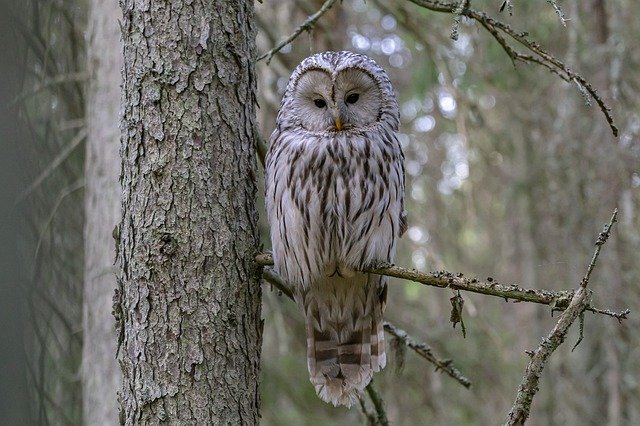
This post is about one of our absolute favorite parts of nature: owls. Have you seen our website? We love owls. They represent the wild and mysterious. And let’s face it. They are utterly stunning creatures.
We’re not alone as owl aficionados. Owls have fascinated people for millennia. We’ve crafted stories about them and even adopted them as a symbol of wisdom. Their admiration is merited. Owls are fast, efficient hunters. They wear amazing camouflage. Have sharp beaks and talons. Incredible hearing. And they are just adorable with their large, round heads, huge eyes and flat faces.

Owls are represented by over 200 species. These birds of prey are solitary (for the most part) and nocturnal. Owls hunt mostly small mammals, insects, and other birds, although a few species specialize in hunting fish. They are found in all regions of the Earth except the polar ice caps and some remote islands.
Almost every quality of owls that we know and admire is intended to make it the perfect night predator. That’s nature for you! As its hunting strategy depends on stealth and surprise, the dull coloration of their feathers can make an owl look almost invisible under certain conditions. Just as cool, an owl’s feathers have serrated edges which help to muffle an owl's wing beats, the raptor to be practically silent in flight.
Impressive? Don’t forget that these raptors date back to prehistoric times. They have had 70 million years to evolve to be masters of evading detection from prey. That has led to their amazing ability to tilt their heads 270 degrees, to their large eyes which equip them with incredible night vision, as well as their ears placed at the back of their heads—the better for them to see what is coming from behind.
But don’t take our word for it. You and your child can do your owl exploration online using well-designed resources such as owling.com or you can head out into the wild to look for the critters in the flesh. And to be honest, to see one in the wild is exhilarating and magical.

How to explore owls
You don’t need to be a serious birder to go owling. It’s the perfect outdoor activity for the whole family. But you will have to earn the right to see an owl. After all, owls are masters of camouflage. And they won’t just come out and perch on your finger.
What is owling
Owling is the act of going out at night (usually) to look for owls. It is like no other form of bird watching and requires a different set of skills, mainly because it is done at night.
When to go owling
Winter is an excellent time to head out to look for owls. During this time of year, many owls begin looking for mates and they are quite vocal about it! While it may be quite cold on a winter’s night, an added benefit of heading out this time of year is that most trees are without leaves, making it easier to see an owl’s silhouette.
While most owls are active at night, some are far more active during the day, one of those being the burrowing pygmy owl. Dawn and dusk are good times to go, since there is a bit of light and the owls are more active (depending on the species and location). And the magnificent great horned owl begins calling around dusk.
Owls are not able to forage for food very well on a rainy night. Especially if it has rained for a few nights consecutively, it would be a great idea to go owling the night after when all the owls are hungry and out looking for prey.
Be sure to steer clear of windy nights because it can be hard to hear.
When owling, it's best to avoid using a flashlight unless you need to since they can scare off the owls. For this reason, nights with bright moonlight are perfect for owling.
Where to go owling
You can look and listen for owls in wild places. That might be at a wildlife sanctuary, local wooded area or even in your own backyard! Owls love to roost inside hollow trees so always gently check their hiding place but take care not to disturb the wildlife.
“Hoo” will you see when you head out owling
That depends on where you are looking and which species frequent the area. The great horned owl is one of the most charismatic creatures to watch. And ff you live in North America, these are some of the most adaptable large birds on the continent.
Another contender is the snowy owl. Usually, a species of the Arctic but during some years, snowy owls can be found in many parts of North America.
Of course, you can check in with local birding groups on their owl finds or on the iNaturalist app to help figure out which species may be lingering.
How to go owling
You can head out on your own or on an owl prowl, or guided owl hike with local nature groups like Audubon. Never go on a tour that baits owls with mice from pet shops which can acclimate it to humans as well as pose a danger.
If there is a secret to owling, it’s to listen to local owl calls ahead of time. Owls are defined by their call. This is how they find each other and how they evolve into unique species. As the top avian predators of the night, their calls are critical to their survival. A vivid color might help you find a mate in the day but at night this must be done by sound.
There are likely only a handful of species in your local area (there are 19 species of owls in North America and 13 species in Europe) so it should be easy to learn owl calls. Try to make a fun game out of it. Play the owl sound and the first to name it, wins. Owl bingo anyone?
When setting out to see any wild critter, the key is always to think of its behavior. Owls are birds, and so they do the same kinds of things that all birds do: find food, preen their feathers, defend their territory, lay eggs and raise their young. But, unlike most other birds, owls do these things in the dark.

The following "owl clues" based on owl behavior will be useful when you head out owling:
Whitewash. Whitewash is essentially the owl’s excrements, which are usually found at the bottom of trees which have been roosted on.
Pellets. Owls will often leave ‘pellets’ at the bottom of trees they have roosted on. These are regurgitated bones, fur, and feathers from their most recent meal.
Counterparts. Did you know that certain birds will appear in the daytime in place of certain birds that come in the night? These species pairs are known as “ecological counterparts.” One common pair of ecological counterparts is the red-tailed hawk and the great horned owl. If you see hawks in the daytime, chances are owls will be there at night.
Feathers. Look for owl feathers on the forest floor. Owl feathers are usually very large and are extremely soft, more so than most other birds.
Even with the best strategies and equipment, finding an owl can take a long time, which is why it’s important to be patient and to have fun while you’re out owling. Make sure to appreciate all forms of nature when out owling, because you’re likely to see a whole lot more than just owls.
Here are some great tips from the experts at owling.com:
- Bring along a pair of binoculars equipped with night vision. When owling, it is actually better to use a lower magnification, since that will let you see a greater field of vision and give you a better chance of actually finding what you’re looking for.
- Many owlers cup their hands behind their ears to help locate the sound.
- Owlers will often move around to “triangulate” where a sound is coming from (the owls will do this to find you!).
- Many owls can locate small animals by sound alone so being quiet is very important.
- The owls also have much better night vision than you do. When looking for them at night, stay in the shadows, under the trees, and out of plain view. Ideally, you want to see them before they see you.
- Give them plenty of space. If you are watching or taking photos during the day, remember this is their rest period. If you are watching or taking pictures during the night, remember this is the time the owls feed. Interfering with the owls hunting for an extended period can potentially damage them. These balances are very fragile. Enjoy nature, be considerate and gently cautious.














Wow- thanks for the info! I have heard owls out my window, but I think it is time we good on the search!